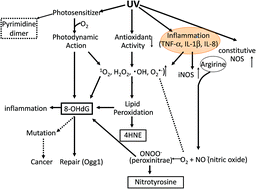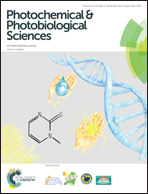Current concept of photocarcinogenesis†
Abstract
There is ample evidence demonstrating that solar ultraviolet light (UV) induces human skin cancers. First, epidemiological studies have demonstrated a negative correlation between the latitude of residence and incidence and mortality rates of both melanoma and non-melanoma skin cancers in homogeneous populations. Second, skin cancer can be produced in mice by UV irradiation; the action spectrum of photocarcinogenesis falls into UVB (280–320 nm). Third, patients with genetic disorders that lead to deficiencies in repairing UV-induced DNA damage are prone to develop cancers in sun-exposed areas of the skin. Photocarcinogenesis is a multistage process that involves initiation, promotion, and progression. In addition UV induced immunosuppression is closely involved in photocarcinogenesis. Accumulation of DNA lesions caused by UV in several cancer related genes plays a crucial role in carcinogenesis. Indeed, even in actinic keratosis, precancerous lesions, genetic alterations can be observed. A conventional knowledge demonstrated that UVB induced DNA lesion causes genetic mutation (initiation) and UVB-inflammation (sunburn) induces promotion. However recent findings revealed that the photocarcinogenesis pathway is more complex consequences where each of these processes, mediated by various cellular, biochemical, and molecular changes, are closely related to each other. The pyrimidine photoproducts that result from direct DNA damage induced by UV are involved in developing skin cancer through mutations that lead to the upregulation or downregulation of signal transduction pathways, cell cycle dysregulation, and depletion of antioxidant defenses. In addition pyrimidine dimers have been shown to trigger UV induced immunosuppression, which also plays an important role in photocarcinogenesis, partly by upregulation of IL-10, an immunosuppressive cytokine. UV also produces oxidative stress and oxidative DNA damage in skin cells, which cause alteration of the genes involved in the cell cycle, apoptosis and modification of cell signaling by redox regulation, resulting in inflammation. It has been shown that in Ogg1 knockout mice which are deficient in repairing 8-oxo-7, 8-dihydroguanine (8-oxoG), UVB irradiation up-regulates the inflammatory gene, implying that 8-oxoG is involved in triggering inflammation. In this review I summarize the state of the art knowledge regarding photocarcinogenesis including experimental data and implication for clinical viewpoints.

- This article is part of the themed collection: The 16th International Congress on Photobiology

 Please wait while we load your content...
Please wait while we load your content...